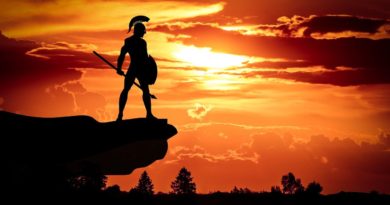Four Horsemen and Army of the Apocalypse
By Derek Gilbert
One of the most interesting and overlooked parallels in Scripture is the location of the Israelite camp just before the conquest of Canaan and what appears to be the route of attack by the end-times army of the Antichrist when it comes against the holy mountain of God at Jerusalem. We know from Exodus and Deuteronomy that the Israelites camped on the plains of Moab before crossing the Jordan to begin the assault on Jericho.
Likewise, Gog of Magog, whom we’ll show later to be the Antichrist, will bring his army to the very same place—to die.
Ezekiel 39:1–6, 11 tells us:
“And you, son of man, prophesy against Gog and say, Thus says the Lord
GOD: Behold, I am against you, O Gog, chief prince of Meshech and
Tubal. And I will turn you about and drive you forward [or, ‘drag you
Along’], and bring you up from the uttermost parts of the north [yerekah
tsaphon, Baal’s mount of assembly], and lead you against the mountains
of Israel. Then I will strike your bow from your left hand, and will make
your arrows drop out of your right hand. You shall fall on the mountains of
Israel, you and all your hordes and the peoples who are with you. I will
give you to birds of prey of every sort and to the beasts of the field to be
devoured. You shall fall in the open field, for I have spoken, declares the
Lord GOD. I will send fire on Magog and on those who dwell securely in the
coastlands, and they shall know that I am the LORD.”
“The Valley of the Travelers, east of the sea.” Many of us have read that verse and paid little attention to the name of Gog’s burial place, maybe assuming it was symbolic.
If “the sea” is the Mediterranean, that could be anyplace from Dan to Beersheba—in other words, just about anywhere in Israel. This has allowed prophecy
scholars to keep the war of Gog and Magog separate from Armageddon, which many still incorrectly place at Megiddo. But “east of the sea” actually means ancient Moab, which was east of the Dead Sea. This opens a fascinating new look at the war of Gog and Magog.
The Hebrew word rendered “traveler” is ōbĕrîm, a plural form of the verb ʿbr, which means “to pass from one side to the other.”
In this context, then, a Traveler is a spirit that passes from one plane of existence to another, in the same sense that the ancient Greeks believed the dead had to travel across the River Styx to reach or return from the underworld.

It is interesting that this was the very place, just northeast of the Dead Sea, where Israel camped before crossing the Jordan to begin the conquest of Canaan. How do we know this? Because places where Israel stopped after the Exodus refer to the dead, and specifically to the Travelers.
Numbers 21:10-11 says: “And the people of Israel set out and camped in Oboth. And they set outfrom Oboth and camped at Iye-abarim, in the wilderness that is opposite Moab, toward the sunrise.”
Oboth has the same sense as ōbĕrîm, although it’s more specific. Oboth derives from ʾôb, which refers to necromancy, the practice of summoning and consulting with spirits of the dead. ʾÔb, in turn, is related to the Hebrew word ʾab, which means “father.” In the Old Testament, the word “fathers” most often refers to one’s dead ancestors.
For example, Genesis 47:29-30 says:
“And when the time drew near that Israel must die, he called his son
Joseph and said to him, ‘If now I have found favor in your sight, put your
hand under my thigh and promise to deal kindly and truly with me. Do not
bury me in Egypt, but let me lie with my fathers [ăbōṯ].’”
Oboth, then, means “Spirits of the Dead.”
And, you’ve probably already noticed that the second half of the compound name Iye-abarim is very similar to ōbĕrîm. Excellent work! Iye-abarim means “heaps (or ruins) of the Travelers.” Not coincidentally, this area east of the Jordan Rift Valley, from ancient Moab to Bashan, southeast of Mount Hermon, is home to thousands of dolmens, megalithic tombs made from slabs of basalt and limestone that weigh as much as fifty tons.5 While dolmens are found all over the world, there are more of these tombs in Jordan and the Golan Heights than anywhere else.

They are simple structures, mostly in a trilithon formation—two standing stones and a capstone, like a “table” across the top, with no cement holding the slabs together. Sometimes additional stones are placed at the front and back, occasionally with a porthole cut to include a frame around the opening cut to hold a removable flat stone. Skeletal remains have been found at enough of them to conclude that the primary function of these intriguing structures was burial of the dead.
These ancient monuments are fascinating for a couple of reasons. First, although Iye-Abarim was located just northeast of the Dead Sea, the highest concentration of dolmens in the region is on and around the Golan Heights, where the Rapha king Og and the deity called Rapi’u, King of Eternity, once ruled. A recent survey of the Golan found more than five thousand megalithic burial sites, most of which are dolmens.
In Jordan, another twenty thousand dolmens have been found, although many are threatened by the expansion of modern cities and quarrying for rock and gravel. (Which makes sense—dolmens were built where great big rocks were close to the surface and easy to find.) Secondly, and this is an interesting admission: Scholars really don’t know anything about the people who built them.
The dolmens are generally dated to the third millennium (3000–2000) BC. On the Golan Heights, they are more narrowly dated to between 2250 BC and about 1800 BC. Based on pottery shards found near some of the dolmens in Jordan, the megaliths closer to the Dead Sea may be as old as the beginning of the Early Bronze Age, circa 3300 BC.

If the Bible is accurate, and it is, then the time and location suggest that the builders of the dolmens were the Rephaim tribes, who constructed them in the centuries before Abraham’s arrival in the area. By the time the Israelites returned from Egypt around 1406 BC, only Og’s small kingdom remained of the Rephaim—possibly the last of the dolmen-builders in the Levant.
It’s tempting to go overboard with speculation, but we don’t serve our God well by wandering too far afield without evidence. Still, credentialed scholars link the megaliths to the Rephaim, although instead of identifying the dolmen-builders as Rephaim they tend to view things the other way around, believing the dolmens “were the basis for belief in giants, the Rephaim, Anakim, Emim, Zamzummim, and the like.”

In other words, scholars think the people who moved into the lands alongside the Jordan River invented stories of giants because they imagined that really big men must have moved those really big rocks.
The evidence suggests otherwise. More on that next month.

Derek Gilbert hosts SkyWatchTV, a weekly Christian television program, and co-hosts SciFriday, a weekly television program that looks at science news with his wife, author, and analyst Sharon K. Gilbert. His broadcast career spans nearly four decades, with stops in Little Rock, Saint Louis, and Philadelphia, and he’s been interviewing guests for his podcast, A View from the Bunker, since 2009. Derek is author of the groundbreaking books The Great Inception and Last Clash of the Titans. He’s also the co-author with Josh Peck of The Day the Earth Stands Still, which exposes the occult origins of the modern UFO phenomenon. Bad Moon Rising: Islam, Armageddon, and the Most Diabolical Double-Cross in History was released in the summer of 2019. Derek and Sharon recently released Veneration: Unveiling the Ancient Realms of Demonic Kings and Satan’s Battle Plan for Armageddon, about ancient death cults and the Bible. Their newest book, Giants, Gods, and Dragons: Exposing the Fallen Realm and the Plot to Ignite the Final War of the Ages, was released November 30, 2020 and became a #1 “Hot New Release.” His newest book, The Second Coming of Saturn: The Great Conjunction, America’s Temple, and the Return of the Watchers, was just released on November 15. Derek is a popular conference speaker, a lifelong fan of the Chicago Cubs, prefers glasses to contacts, and has been known to sing the high part in barbershop and gospel quartets. Find out more: www.derekpgilbert.com, www.gilberthouse.org, www.vftb.net, and www.SkyWatchTV.com.



